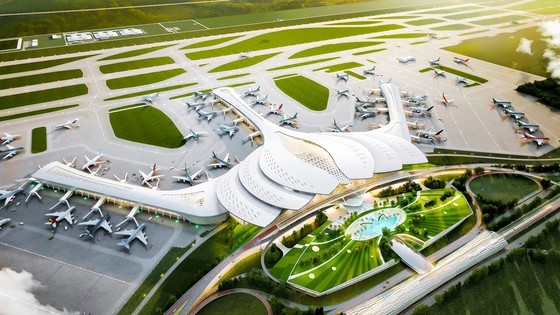 The design of Long Thanh International Airport. (Photo: SGGP)
The design of Long Thanh International Airport. (Photo: SGGP)
Under the proposed plan, the 28 airports will have combined capacity of 278 million passengers to ensure that more than 95 percent of the population can access an airport within a distance of 100km.
The plan estimates that about VND400 trillion (US$17.68 billion) will be needed to develop the airport system until 2030, accounting for 22 percent of the total demand for capital of the whole sector.
In 2050, the country expects to have 29 airports, including 15 domestic ones. An airport in the southeast of Hanoi will be built.
The plan also includes a list of national key projects with investment priority, including the first phase of Long Thanh International Airport with a capacity of welcoming 25 million passengers per year; the construction of T3 terminal at Tan Son Nhat International Airport (Ho Chi Minh City), and T2 terminal at Noi Bai International Airport (Hanoi) to raise their capacity to handling 20 million and 15 million passengers per year, respectively.
Priority will also be given to the expansion and construction of airports in remote, mountainous and island areas, such as Dien Bien, Con Dao island, Sa Pa and Pleiku.
A representative from the Ministry of Transport said that the ministry has suggested amending and supplementing a number of relevant legal regulations to mobilize non-State budget resources for the scheme, while building and issuing regulations on the selection of investors for aviation service projects at airports.
For new airports, public-private partnership will be preferred, excepting for those of national significance and strategic military and security importance as well as those in border and island areas, which will be invested by State capital.
The plan estimates that about VND400 trillion (US$17.68 billion) will be needed to develop the airport system until 2030, accounting for 22 percent of the total demand for capital of the whole sector.
In 2050, the country expects to have 29 airports, including 15 domestic ones. An airport in the southeast of Hanoi will be built.
The plan also includes a list of national key projects with investment priority, including the first phase of Long Thanh International Airport with a capacity of welcoming 25 million passengers per year; the construction of T3 terminal at Tan Son Nhat International Airport (Ho Chi Minh City), and T2 terminal at Noi Bai International Airport (Hanoi) to raise their capacity to handling 20 million and 15 million passengers per year, respectively.
Priority will also be given to the expansion and construction of airports in remote, mountainous and island areas, such as Dien Bien, Con Dao island, Sa Pa and Pleiku.
A representative from the Ministry of Transport said that the ministry has suggested amending and supplementing a number of relevant legal regulations to mobilize non-State budget resources for the scheme, while building and issuing regulations on the selection of investors for aviation service projects at airports.
For new airports, public-private partnership will be preferred, excepting for those of national significance and strategic military and security importance as well as those in border and island areas, which will be invested by State capital.
























